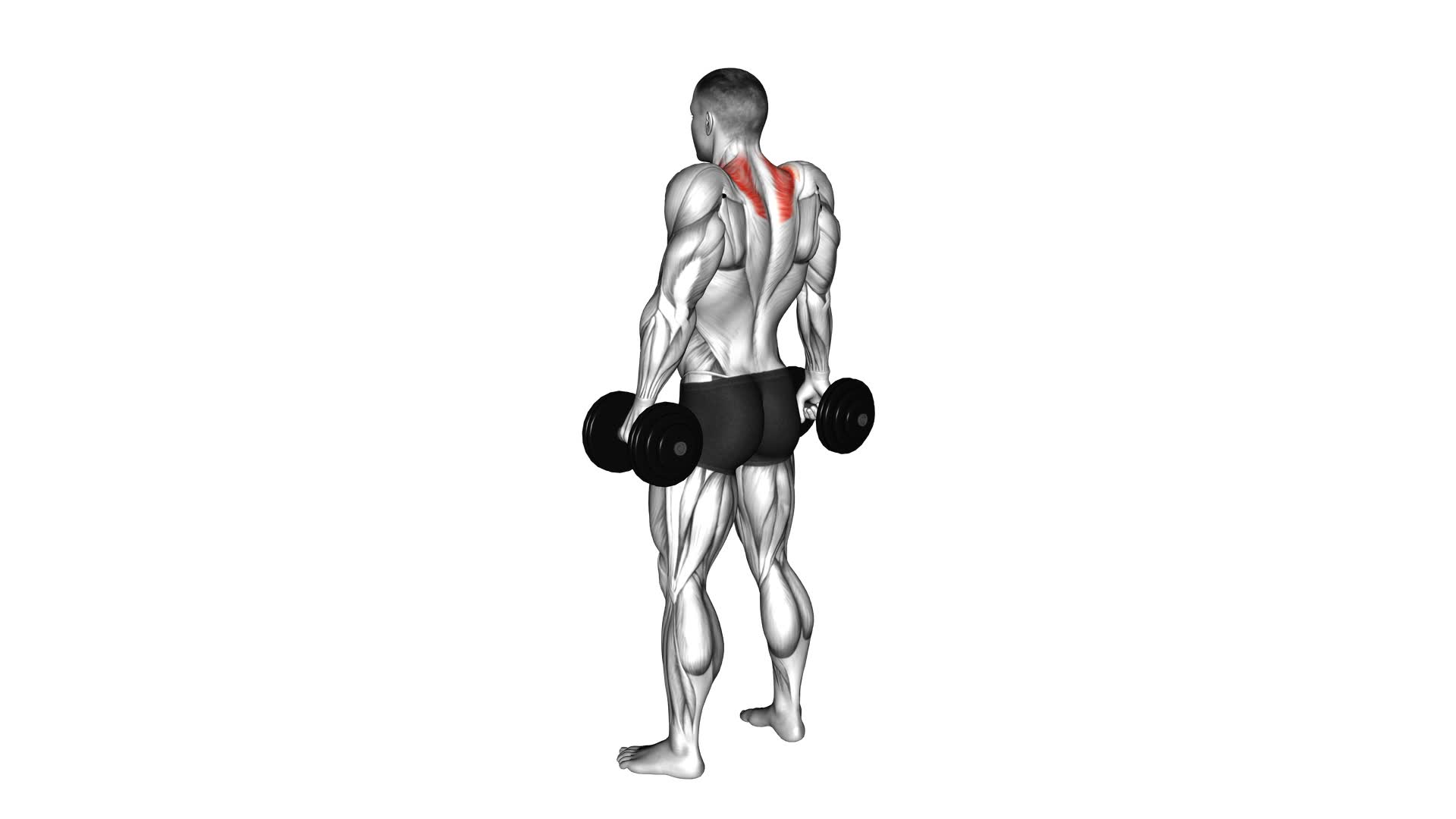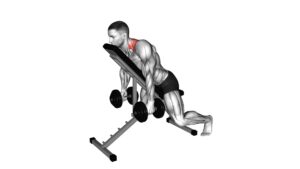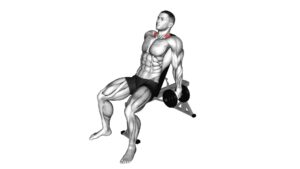Dumbbell Shrug – Video Exercise Guide & Tips

In this video exercise guide, you'll learn all about the dumbbell shrug and how it can benefit you.
Watch This Exercise Video
Grab your dumbbells and get ready to strengthen and tone your trapezius muscles.
We'll show you the proper form and technique, as well as some variations to keep things interesting.
Plus, we'll share tips to help you maximize your results and avoid common mistakes.
Get ready to level up your workout with the dumbbell shrug!
Key Takeaways
- Dumbbell shrugs increase shoulder and upper back strength and target the trapezius muscles.
- Proper form and technique are crucial to avoid injuries and maximize results.
- Variations of dumbbell shrugs can target different parts of the trapezius muscle and prevent plateaus.
- Gradually increasing weight and incorporating variations can help improve technique and add variety to the exercise routine.
Benefits of Dumbbell Shrugs
You can experience increased shoulder and upper back strength through dumbbell shrugs. Proper form is crucial to reap the maximum benefits from this exercise. One of the main advantages of dumbbell shrugs is that they target the muscles in your shoulders and upper back, specifically the trapezius muscles. By performing this exercise with proper form, you can strengthen these muscles, leading to improved posture and reduced risk of injuries.
To ensure you're maximizing your results, it's important to maintain proper form throughout the exercise. Start by standing with your feet shoulder-width apart, holding a dumbbell in each hand. Keep your arms straight by your sides and your shoulders relaxed. Then, lift your shoulders up towards your ears, squeezing your shoulder blades together at the top. Hold this position for a moment before slowly lowering your shoulders back down.
Remember to engage your core and avoid using momentum or swinging your arms to lift the weights. It's also crucial to choose an appropriate weight that challenges you but allows you to maintain proper form. By following these tips and incorporating dumbbell shrugs into your workout routine, you can experience the numerous benefits of increased shoulder and upper back strength.
Equipment Needed for Dumbbell Shrugs
To perform dumbbell shrugs effectively, you'll need some essential equipment.
The main piece of equipment required is a pair of dumbbells. It's recommended to choose a weight that challenges you without compromising your form.
If you don't have access to dumbbells, you can also use alternative objects like kettlebells or barbells to achieve a similar effect.
Essential Equipment for Shrugs
What equipment do you need for dumbbell shrugs?
When performing dumbbell shrugs, there are a few essential pieces of equipment that you'll need. The first and most obvious is a pair of dumbbells. Choose a weight that challenges your muscles without compromising proper form and technique.
It's also important to have a flat and stable surface to stand on, such as a weightlifting platform or a rubber mat. This will ensure that you have a solid base to perform the exercise and reduce the risk of injury.
Additionally, consider using wrist straps or grips to enhance your grip strength and prevent the dumbbells from slipping out of your hands.
Alternatives to Dumbbells
For an alternative to dumbbells, consider using other weighted objects such as kettlebells or barbells for your dumbbell shrugs.
Kettlebells are a great option as they provide a similar grip and motion to dumbbells, allowing you to target your traps effectively. You can hold a kettlebell in each hand and perform shrugs just like you'd with dumbbells.
Barbells are another alternative that can be used for dumbbell shrugs. By holding a barbell with an overhand grip in front of your thighs, you can perform the same upward shrugging motion.
These alternatives provide a different feel and challenge to your muscles, allowing you to switch up your routine and continue to make progress.
Additionally, if you don't have access to any weighted equipment, you can also perform bodyweight shrugs by simply shrugging your shoulders up and down without any added resistance.
Remember to maintain proper form and engage your traps throughout the movement.
Proper Form and Technique for Dumbbell Shrugs
With dumbbell shrugs, you can effectively target and strengthen your trapezius muscles by lifting the weights upwards and towards your ears. To ensure proper form and technique, it's important to avoid common mistakes and gradually increase the weight as you progress.
One common mistake to avoid is using excessive momentum to lift the weights. Instead, focus on using slow and controlled movements, allowing your trapezius muscles to fully engage throughout the exercise. This will maximize the effectiveness of the shrugs and prevent potential injuries.
Another mistake to avoid is shrugging your shoulders too high or rolling them forward. This can lead to unnecessary strain on your neck and upper back. Instead, focus on lifting your shoulders straight up towards your ears, keeping your neck in a neutral position. This will help target your trapezius muscles more effectively.
As you progress in strength, it's important to gradually increase the weight to continue challenging your muscles. However, it's crucial to maintain proper form and technique, even with heavier weights. This will ensure that you're effectively targeting your trapezius muscles and reducing the risk of injury.
Variations of Dumbbell Shrugs
To further enhance your trapezius muscle workout, incorporate different variations of dumbbell shrugs into your routine. Here are some variations you can try:
- Single-arm dumbbell shrugs: Hold a dumbbell in one hand and perform the shrug motion, focusing on squeezing your trapezius muscle on that side. This variation helps improve unilateral strength and balance.
- Dumbbell shrugs with a pause: After lifting the dumbbells, hold the top position for a few seconds before lowering them back down. This pause allows for increased time under tension and muscle activation, leading to greater gains.
- Behind-the-back dumbbell shrugs: Instead of holding the dumbbells in front of your body, hold them behind your back. This variation places more emphasis on the lower portion of the trapezius muscle, providing a different stimulus for growth.
By incorporating these variations into your dumbbell shrug routine, you can target different parts of your trapezius muscle and improve your technique. This will help prevent plateaus and keep your workouts challenging and effective.
Now, let's move on to the next section where we'll discuss tips for maximizing results with dumbbell shrugs.
Tips for Maximizing Results With Dumbbell Shrugs
To maximize your results with dumbbell shrugs, it's important to focus on proper form techniques. Make sure to keep your shoulders relaxed and avoid shrugging your neck.
Additionally, gradually increase the weight you use over time to continue challenging your muscles and promote growth.
Lastly, consider incorporating variations of the exercise, such as single-arm or behind-the-back shrugs, to add variety to your routine and target different muscle groups.
Proper Form Techniques
To maximize your results with dumbbell shrugs, focus on maintaining proper form throughout the exercise. Here are some tips to help you perform the exercise correctly and avoid common mistakes:
- Keep your back straight and shoulders relaxed.
- Avoid using your arms to lift the dumbbells; instead, engage your traps to do the work.
- Lift the dumbbells with a controlled motion, avoiding any jerking or swinging.
- Squeeze your shoulder blades together at the top of the movement for maximum contraction.
By following these proper form techniques, you'll ensure that you're targeting the muscles effectively and minimizing the risk of injury.
Now that you have mastered the correct form, let's move on to the next section where we'll discuss the importance of gradually increasing weight to continue challenging your muscles and making progress.
Increasing Weight Gradually
As you progress in your dumbbell shrug workouts, it's important to gradually increase the weight you're lifting to continue challenging your muscles and maximize your results. This concept is known as progressive overload, which involves gradually increasing the intensity of your workouts over time.
By consistently challenging your muscles with heavier weights, you force them to adapt and grow stronger. However, it's crucial to approach increasing weight gradually to avoid injury and ensure proper form. Start by adding small increments of weight, such as 5-10 pounds, and focus on maintaining proper technique throughout the exercise.
Listen to your body and only increase the weight when you feel confident and comfortable. Remember, slow and steady progress is key to achieving the best results with dumbbell shrugs.
Incorporating Variations for Variety
Switch up your dumbbell shrug routine by incorporating variations for added variety and to maximize your results. Here are some ways to add variety to your dumbbell shrugs:
- Incorporating resistance bands: Attach resistance bands to the dumbbells and perform shrugs. The bands will provide additional resistance throughout the entire range of motion, making the exercise more challenging and effective for building shoulder and trap muscles.
- Using kettlebells: Instead of using dumbbells, try using kettlebells for your shrugs. The unique shape and handle of kettlebells will engage your muscles differently and provide a different stimulus to your traps.
- Changing hand grip: Switch between an overhand grip and an underhand grip to target different areas of your traps.
By incorporating these variations, you can keep your workouts interesting and continue to challenge your muscles in new ways.
Now, let's discuss some common mistakes to avoid when performing dumbbell shrugs.
Common Mistakes to Avoid When Performing Dumbbell Shrugs
When performing dumbbell shrugs, be mindful of the common mistakes that can hinder your progress. To ensure you're maximizing the effectiveness of this exercise, it's important to maintain proper form techniques.
One common mistake to avoid is using too much weight. While it may be tempting to load up the dumbbells, using excessive weight can compromise your form and increase the risk of injury. Instead, start with a weight that allows you to perform the exercise with proper technique and gradually increase the weight as you become more comfortable and stronger.
Another mistake to avoid is shrugging your shoulders too high. While it's important to lift your shoulders, it's crucial to keep the movement controlled and within a range of motion that feels comfortable for you. Going too high can put unnecessary stress on the neck and upper traps, leading to discomfort or injury.
Additionally, avoid using momentum to lift the dumbbells. The shrug should be a slow and controlled movement, focusing on contracting the trapezius muscles. Using momentum not only reduces the effectiveness of the exercise but also increases the risk of straining or pulling a muscle.
Frequently Asked Questions
How Many Sets and Reps Should I Do for Dumbbell Shrugs to See Results?
To see results from dumbbell shrugs, you need to focus on workout frequency and proper form. Determine how many sets and reps you can handle comfortably without sacrificing form. Start with 3 sets of 10-12 reps and gradually increase the weight and intensity as you progress.
Remember to engage your traps and avoid shrugging your shoulders towards your ears. Consistency and proper technique are key to achieving desired results.
Can Dumbbell Shrugs Help Improve My Posture?
Dumbbell shrugs can be beneficial for improving your posture. By performing this exercise with proper form, you engage your upper back muscles and strengthen them. This can help counteract the effects of slouching and promote better alignment.
Additionally, dumbbell shrugs can also target your trapezius muscles, which play a role in maintaining good posture. Incorporating dumbbell shrugs into your workout routine can be a great way to work on your posture while also building strength in your upper body.
Is It Necessary to Use Heavy Weights for Dumbbell Shrugs?
Using lighter weights for dumbbell shrugs can still provide many benefits. It's not always necessary to use heavy weights. Lighter weights allow you to focus on proper form and technique. This is important because it helps prevent injuries and ensures you're targeting the correct muscles.
Additionally, using lighter weights can help improve your muscular endurance and promote better muscle control. So don't be afraid to go light and reap the benefits of this exercise.
Can Dumbbell Shrugs Help Me Build Bigger Traps?
Dumbbell shrugs are effective trap building exercises. By targeting the trapezius muscles, they can help you develop bigger traps.
While heavy weights can be beneficial, it's not necessary to use them for dumbbell shrugs. You can still achieve results by using moderate weights with proper form and control.
If you're looking for alternative shoulder exercises, consider exercises like upright rows, barbell shrugs, or farmer's walks. These exercises can also contribute to trap development.
Are Dumbbell Shrugs Safe for People With Shoulder or Neck Injuries?
Dumbbell shrugs can be an effective exercise for building bigger traps. However, if you have shoulder or neck injuries, they may not be safe for you. It's important to prioritize your safety and avoid exercises that could aggravate your condition.
Instead, focus on shoulder mobility exercises and alternative exercises that are safer for your specific injuries. Consulting with a qualified healthcare professional can help you determine the best course of action.
Conclusion
In conclusion, dumbbell shrugs are an effective exercise for targeting and strengthening the muscles in your upper back and shoulders. By using proper form and technique, along with incorporating variations and tips to maximize results, you can enhance your overall fitness and increase muscle definition.
Avoiding common mistakes will help you perform dumbbell shrugs safely and efficiently. Incorporating dumbbell shrugs into your workout routine can contribute to a well-rounded strength training program.

Author
Years ago, the spark of my life’s passion ignited in my mind the moment I stepped into the local gym for the first time. The inaugural bead of perspiration, the initial endeavor, the very first surge of endorphins, and a sense of pride that washed over me post-workout marked the beginning of my deep-seated interest in strength sports, fitness, and sports nutrition. This very curiosity blossomed rapidly into a profound fascination, propelling me to earn a Master’s degree in Physical Education from the Academy of Physical Education in Krakow, followed by a Sports Manager diploma from the Jagiellonian University. My journey of growth led me to gain more specialized qualifications, such as being a certified personal trainer with a focus on sports dietetics, a lifeguard, and an instructor for wellness and corrective gymnastics. Theoretical knowledge paired seamlessly with practical experience, reinforcing my belief that the transformation of individuals under my guidance was also a reflection of my personal growth. This belief holds true even today. Each day, I strive to push the boundaries and explore new realms. These realms gently elevate me to greater heights. The unique combination of passion for my field and the continuous quest for growth fuels my drive to break new ground.







